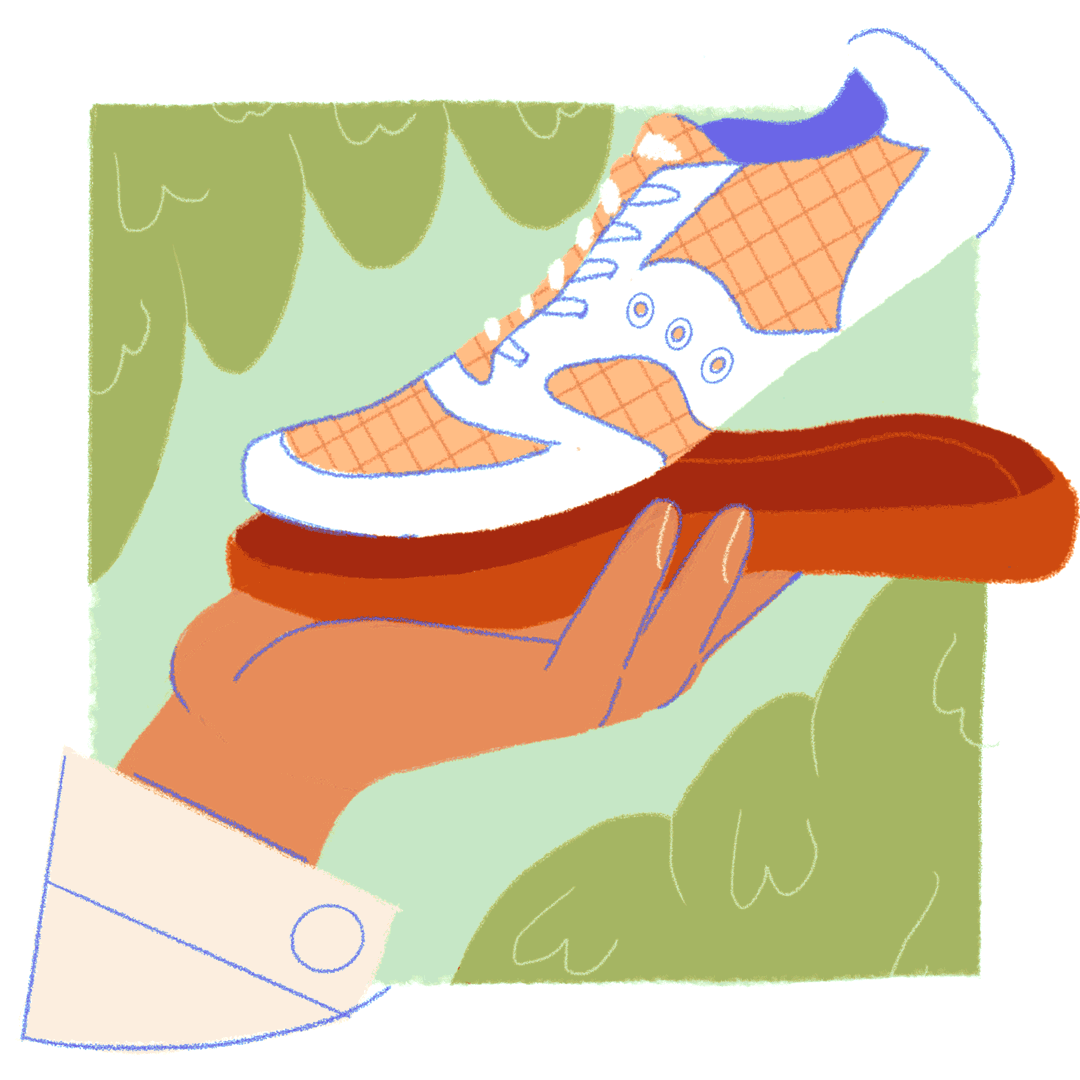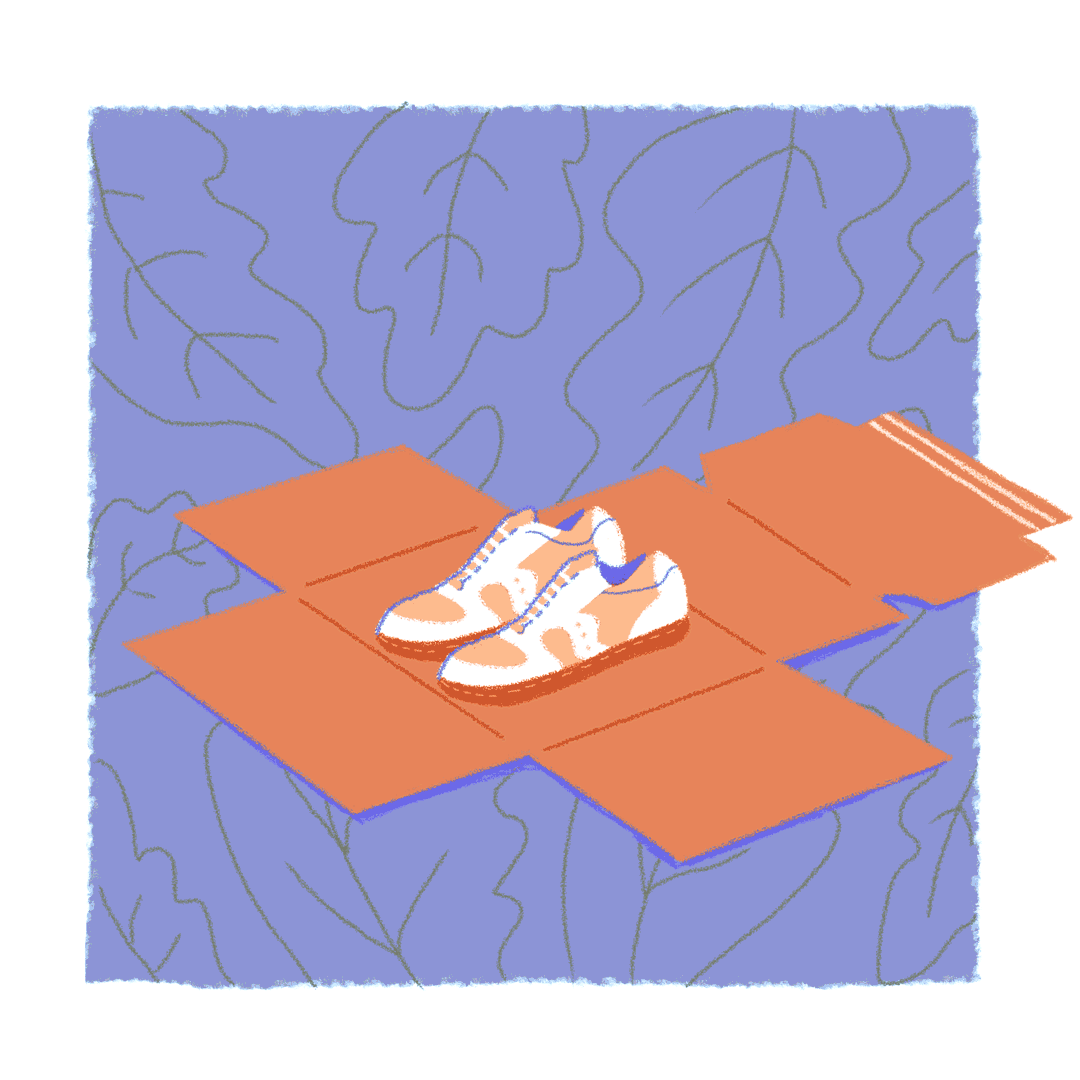Discover the perfect shoe in less than a minute with our shoe finder! Find your perfect fit

The making
of the Jazz
Court RFG
An essay written by Andrea Paulson,
Director of Product Engineering
Illustration by Danni Fuentes
At Saucony, we have some big goals when it comes to sustainability—namely, moving away from the use of virgin plastic in our products. In order to get there, our team has been experimenting with all forms of sustainable design and manufacturing, discovering innovative approaches while also tapping into some classic ones too. I'm Andrea Paulson, head of Product Engineering at Saucony, and this is a peek behind the curtain of how we made the 100% natural Jazz Court RFG.
When we were tasked with making our first shoe using ZERO plastic, picking the upper materials was not the tough part. Natural materials are plentiful. Plant-based fabrics like cotton, jute, hemp, bamboo, even lyocell (cellulose fibers made from wood pulp) are commodity materials these days. Animal-based natural fibers such as silk and wool have been used in garments since an estimated 3000 BCE. It is relatively easy to spec a modern foot covering that uses a majority of non-petroleum derived materials. This approach is not nascent.

So why was it difficult? The hardest part of building natural or eco-friendly footwear is the bottom unit—the part under your foot, not around it. The materials that cushion and protect your body from the concrete and hardwood jungles we now live in are typically far from nature's bounty. They mostly consist of chemically bonded polymers and copolymers, thermoplastics, elastomers, and urethanes. And these synthetics are made from petroleum byproducts—meaning they are plastics. These materials are astounding and have created endless breakthroughs and innovations in both the running industry and the world. Without them, Saucony would not have PWRRUN PB or most other performance technologies we are known for.
But the truth is that not all of our footwear is meant for running or the high-impact nature of it. Not all product needs to use these plastics. And where plastic isn't needed, shouldn't we find something better?
Sometimes to innovate,
you have to revist the past.
Sometimes to innovate, you have to revisit the past. We solved our bottom unit's "plastic problem" using a material known to ancient Mayans—hevea brasiliensis. The hevea plant, or rubber tree, can be tapped for its milk, also known as latex. 2,000 years ago, the Mayans would dip their feet into latex sap to create a protective layer for their soles.. Fast forward to present day, and while the process to make the Jazz Court RFG outsoles is slower than modern synthetic rubber molding, it does not require the curing agents nor the chemical additives of the latter. So while the durable "rubber sole" on your favorite shoe is a blend of TPUs and styrene and must be vulcanized, that's not the case with the Jazz Court RFG. It is one material only: 100% natural rubber. It might not last thousands of years like its synthetic competitor, but that is exactly why we picked it!
Also underfoot is the sock insert. These are often made of EVA or PU and usually cloth-covered for comfort. We countered our normal EVA with a plush undyed wool felt. Naturally renewable, breathable, odor-resistant, and thermo-reactive, so you stay warm when it's cold and cool when it's hot.
So, we solved for the bottom unit. We had nearly succeeded at making a completely natural shoe. The remaining sprint to the finish occurred on the manufacturing floor. Despite very few people asking for this stringent examination of the assembly process, we felt these minutiae were almost paramount to all else. Additionally, a layperson might not know the extents and nuances involved in footwear production, so it was of vital importance for us to take these strides to align the manufacturing and construction with the rest of the bill of materials.

As a brand, we sense the urgency
to make changes to improve these
processes and deliver products
that consider and respect the Earth
and our future on her.
Let me start by saying that footwear manufacturing is fairly archaic. It requires many different machines, and oftentimes many humans to organize all the materials, assemble, and finish product. And it's still hard to automate most processes. This all means that the average shoe feeds heavily on natural resources, the power grid, and manhours. As a brand, we sense the urgency to make changes to improve these processes and deliver products that consider and respect the Earth and our future on her. So we decided to further rewind the tape on footwear manufacturing. To revisit and relearn some of the traditional cobbling methods unadulterated by the industrial era. For example, Indigenous People of North America made footwear using minimal resources and no plastic (moccasins), so while not directly correlated, we already had historical proof of concept.
Before assembling flat material parts into anything that looks like a foot covering, the materials must be cut. On a modern factory cutting line, bolts of fabric arrive and are then silkscreened with guidelines of where the pattern parts should be cut and stitched. These patterns are for the metal cutting dies to be aligned and then stamped for flat parts. The screen-print is usually a UV paint that can be seen under a blacklight. Believing we could do better than paint, we used a trick from baking and swapped in a paste of flour and water to outline our cutting and stitching locations. Once stitching and assembly is complete, the water evaporates, and the dried flour dusts off to reveal a paint-free product.
Adhesives and glues are commonplace in performance running sneakers. They are an easy and effective way to hold materials together, especially soft ones. However, glues can be messy and even the best water-based, natural-polymer adhesives contain levels of ammonia and emulsifying stabilizers. Instead, we used a true sidewall stitch to attach the upper to the latex sole. A cotton thread is sewn through the side of the bottom unit into the upper to hold the parts together. That's it. We had become obsessed.
We had become obsessed.

We had become obsessed.
Before the sidewall stitch is used to affix the bottom, an inking process to mark the upper for alignment usually happens, True to form, even that ink wasn't natural enough for this project, so we took a page from haberdashery and used tailors chalk instead.

We kept going, analyzing each step of the manufacturing process and adapting it to reduce energy and avoid chemical use. We turned back the clocks to a time before machines and manpower were thrown at the industry. We had to be simple and precise, start to finish. We removed parts and procedures, the workers needed to do them, and the energy and heat needed to complete. No hot tunnels—the long rows of ovens and conveyor belts that activate primers and cements for attaching soles. These shoes are "cool" processed to save energy. No hard-plastic counters or box toes. No embossing, no molding, no cementing, no back-part shaping. No welding, no fusing. No unnatural dyes or paints. No metals. No EVA sock inserts. No polyfoam collar padding. We built the shoe one step at a time and cut out anything that wasn't absolutely necessary.
We turned back the clocks to a time before machines and manpower were thrown at the industry.
And we didn't just stop at the shoe itself either. We designed a new and more sustainable shippable shoebox for this style using 100% recycled cardboard and no ink whatsoever. During production, we combined the cardstock layering process with an emboss pressing, again saving steps. The box is topped off with a label made of kraft paper and soy-based ink. All told, we're proud of the subtle branding on this project because, as I'm sure you've figured out by now, the Jazz Court RFG is all about how less truly can be more.
The Jazz Court RFG
is all about how less
truly can be more.

The Jazz Court RFG
is all about how less
truly can be more.
Our hope is that sneaker fans appreciate the level of detail that went into this shoe as much as we appreciate the things we took out. This project ended up being about more than just producing a plastic-free, all-natural shoe. It became an emotional journey through craftsmanship and bygone artistry, to create a bespoke shoe for people who give a damn.




